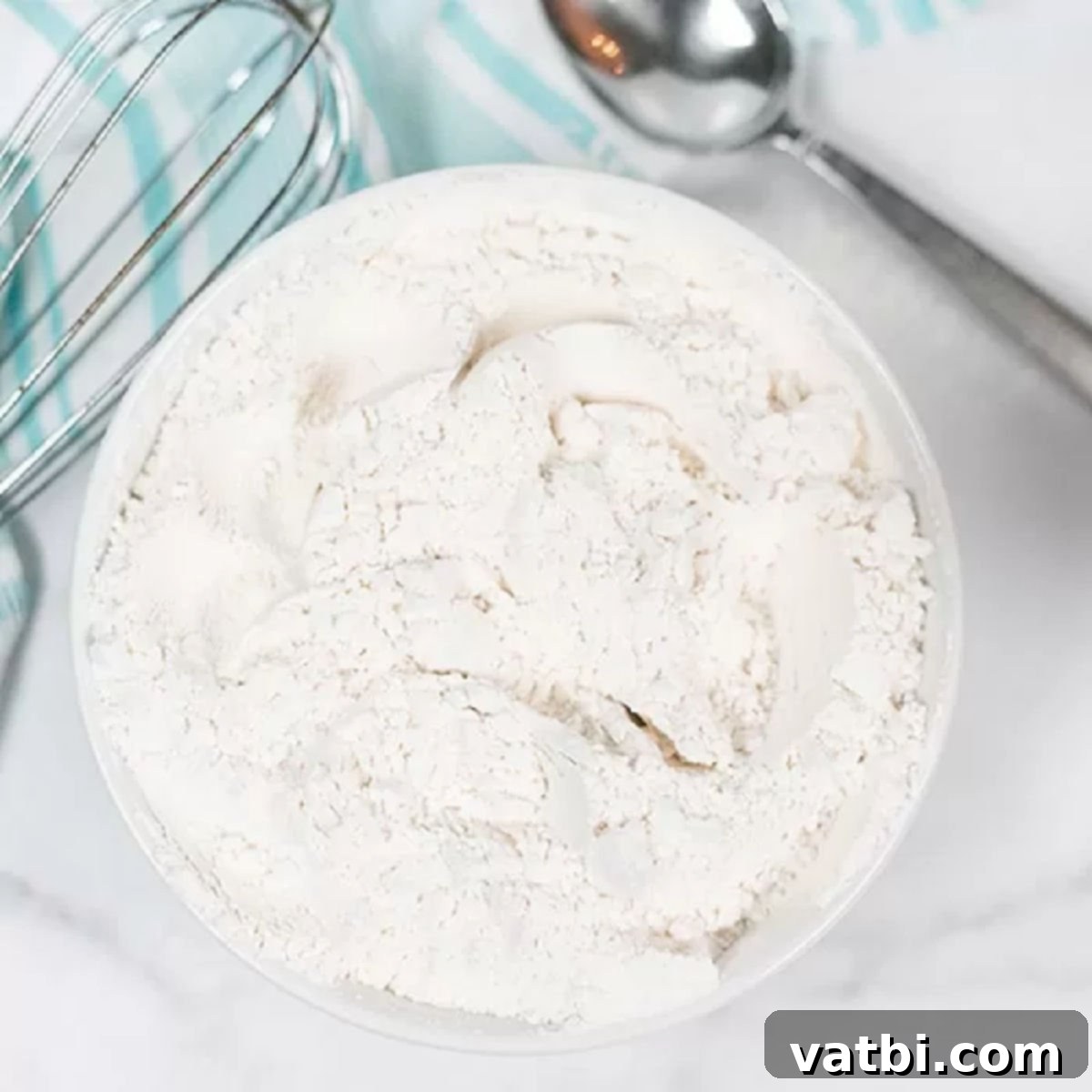Homemade Cake Flour: The Easy 2-Ingredient Substitute for Perfect Baked Goods
Unlock the secret to exceptionally light, tender, and fluffy baked goods with our simple guide on how to make cake flour right in your own kitchen. Forget about rushing to the grocery store or spending extra on specialty ingredients. With just two common ingredients – all-purpose flour and cornstarch – you can create a high-quality cake flour substitute in mere minutes. This homemade version performs just as beautifully as its store-bought counterpart, ensuring your cakes, cupcakes, and pastries achieve that coveted delicate crumb every single time.
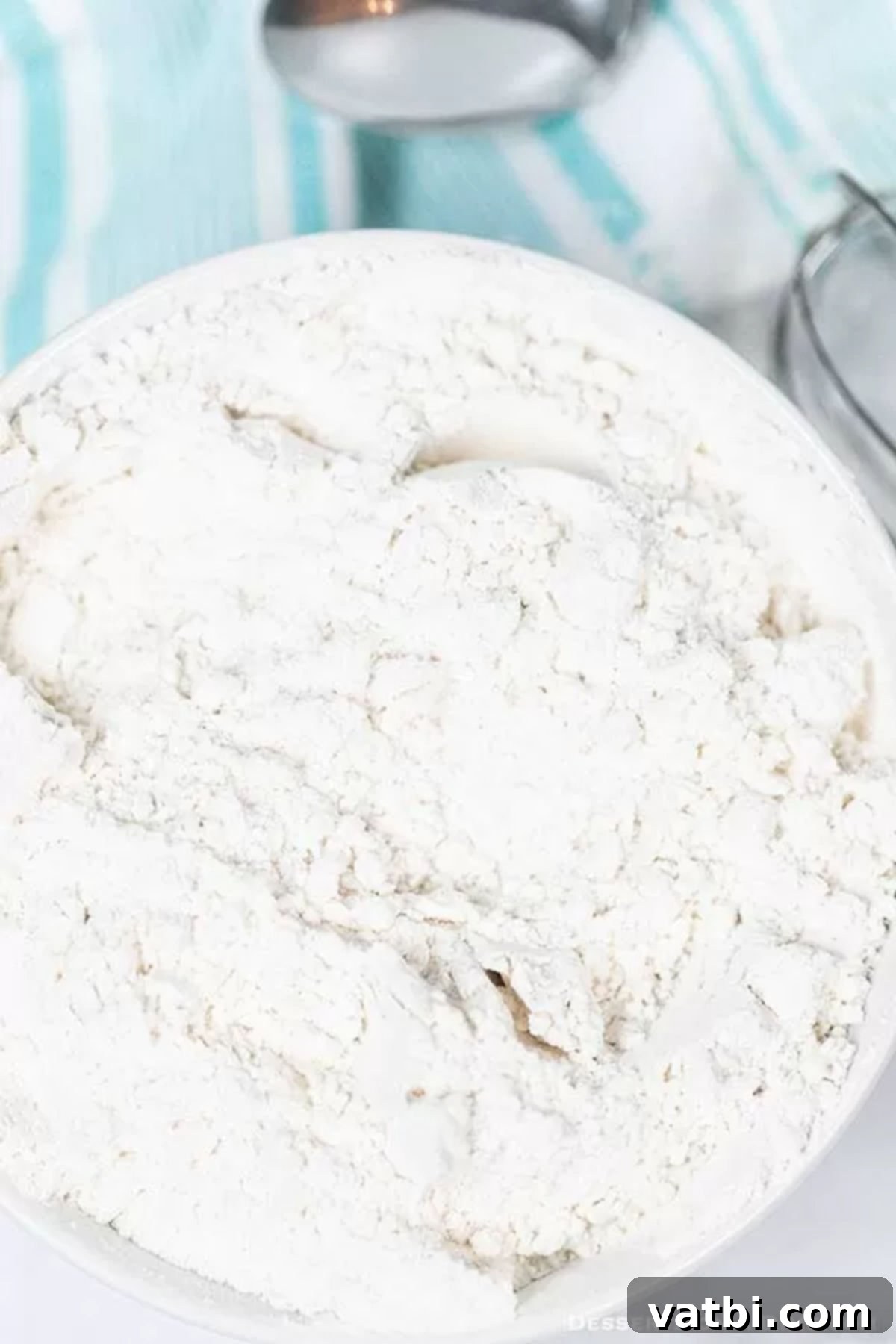
Once you experience the ease and effectiveness of this DIY method, you’ll wonder why you ever bought cake flour from the store. This simple substitution not only saves you precious time and money but also ensures you’re always prepared when a recipe calls for this specialized ingredient. Imagine the convenience of whipping up a batch of cake flour on a whim, eliminating last-minute grocery runs and lengthy checkout lines. It’s a game-changer for any home baker looking to elevate their desserts with minimal effort and maximum impact.
Having homemade cake flour on hand means you can effortlessly embark on your next baking adventure, confident in achieving perfect results. Its quick and easy preparation makes it a favorite staple in my kitchen, alongside other homemade essentials like our Homemade Brown Sugar Recipe. These simple tricks and substitutes are designed to empower you to create delicious treats without the fuss, making baking more enjoyable and less stressful.
Table of Contents
- Why Homemade Cake Flour is a Must-Have for Bakers
- Simple Ingredients You’ll Need
- Easy Step-by-Step Instructions
- Pro Tips for Perfect Homemade Cake Flour
- Frequently Asked Questions About Cake Flour
- Proper Storage for Longevity
- Delightful Recipes That Use Cake Flour
Why Homemade Cake Flour is a Must-Have for Bakers
The magic of cake flour lies in its significantly lower protein content compared to standard all-purpose flour. This crucial difference means less gluten development when mixed, resulting in baked goods that are wonderfully tender, soft, and less dense. While its name suggests a primary use for cakes, its benefits extend far beyond. You can confidently use it to create delicate biscuits, light and airy scones, fluffy pancakes, and even certain cookies, achieving an unparalleled texture that truly elevates your creations. Imagine a muffin with an incredibly tender crumb or a scone that practically melts in your mouth – that’s the power of cake flour.
Many experienced bakers, myself included, often substitute all-purpose flour for cake flour in various recipes because of the superior results it yields. The finer texture and lower protein content contribute to a softer crumb and a more refined mouthfeel. This means your cakes rise higher, maintain their moisture better, and have a more delicate structure that’s simply irresistible. While you might not always have a box of store-bought cake flour stocked in your pantry, knowing how to quickly whip up a homemade version ensures you’re never caught off guard. This simple two-ingredient recipe empowers you to achieve professional-level baking results with minimal effort and maximum convenience, making it an essential skill for any baking enthusiast.
The beauty of this method is its accessibility and reliability. You don’t need special equipment or rare ingredients; just two common pantry staples. This allows you to produce consistent, high-quality results every time, transforming your ordinary bakes into extraordinary desserts that will impress friends and family. It’s a fundamental technique every aspiring and seasoned baker should master to enhance their culinary repertoire.
Simple Ingredients You’ll Need
Making your own cake flour substitute is incredibly straightforward, requiring only two readily available ingredients that you likely already have in your pantry. These two staples work in perfect harmony to mimic the properties of commercial cake flour, allowing you to achieve that perfect delicate crumb and tender texture in all your baked goods.
- All-Purpose Flour. This forms the base of our homemade cake flour. While all-purpose flour has a medium protein content (typically 10-12%) which is higher than true cake flour, we will modify it to reduce its gluten-forming potential. For the best and most consistent results, it’s advisable to use unbleached all-purpose flour. Bleached flour undergoes a chemical process that can affect its interaction with cornstarch and overall baking performance. Always ensure your flour is fresh and free from any off-smells for optimal baking outcomes.
- Cornstarch. This is the magical ingredient that transforms ordinary all-purpose flour into a cake flour substitute. Cornstarch is a pure starch, meaning it contains virtually no protein. When combined with all-purpose flour, it effectively dilutes the overall protein content of the flour mixture, thereby preventing excessive gluten development. Gluten is what gives baked goods structure and chewiness, but for cakes, we want minimal gluten to achieve that desired soft and tender crumb. The cornstarch also aids in moisture absorption, contributing to a more tender and moist final product, much like the qualities found in commercial cake flour.
You’ll find the precise measurements and the full recipe instructions conveniently located at the bottom of this page, in our printable recipe card. This minimal ingredient list makes homemade cake flour an economical and accessible choice for all your delicate baking needs.
Easy Step-by-Step Instructions for Homemade Cake Flour
Creating your own cake flour substitute is a quick and simple process that requires precision in measurement and a bit of patience with sifting. Follow these steps carefully to ensure the best results for your baking projects, and soon you’ll be enjoying wonderfully light and tender baked goods.
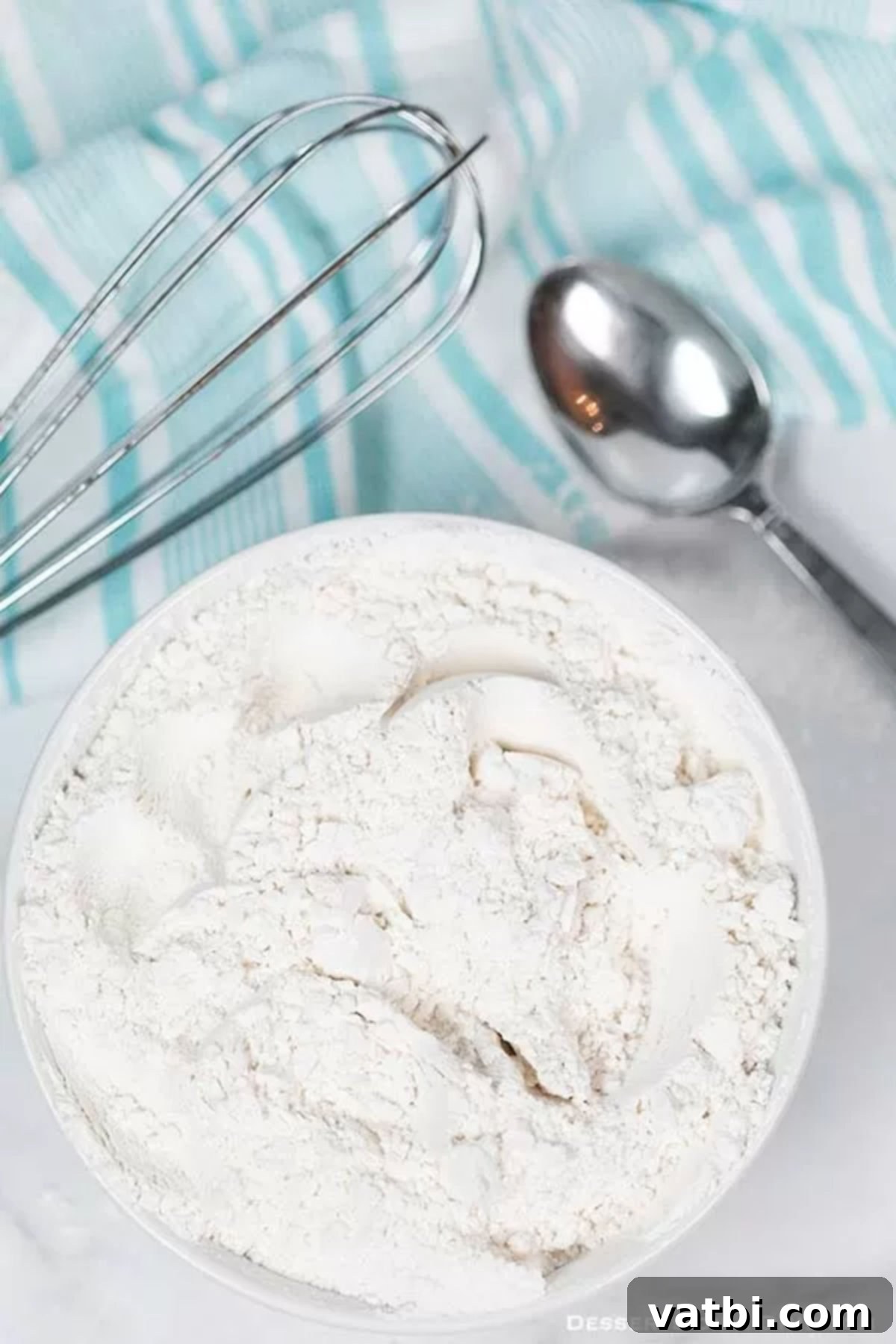
Step 1 – Measure Your Flour Accurately: Begin by precisely measuring 1 cup of all-purpose flour. For accurate results and to prevent over-compacting, use the “spoon and level” method: gently spoon flour into your measuring cup until it overflows, then level it off with the back of a knife or a straight edge. Do not scoop directly from the bag, as this can pack the flour, leading to an incorrect measurement. Once measured, remove exactly 2 level tablespoons of flour from this cup. Set the removed flour aside, as we won’t be using it for this specific substitution ratio. This step is crucial for achieving the correct protein-to-starch ratio.
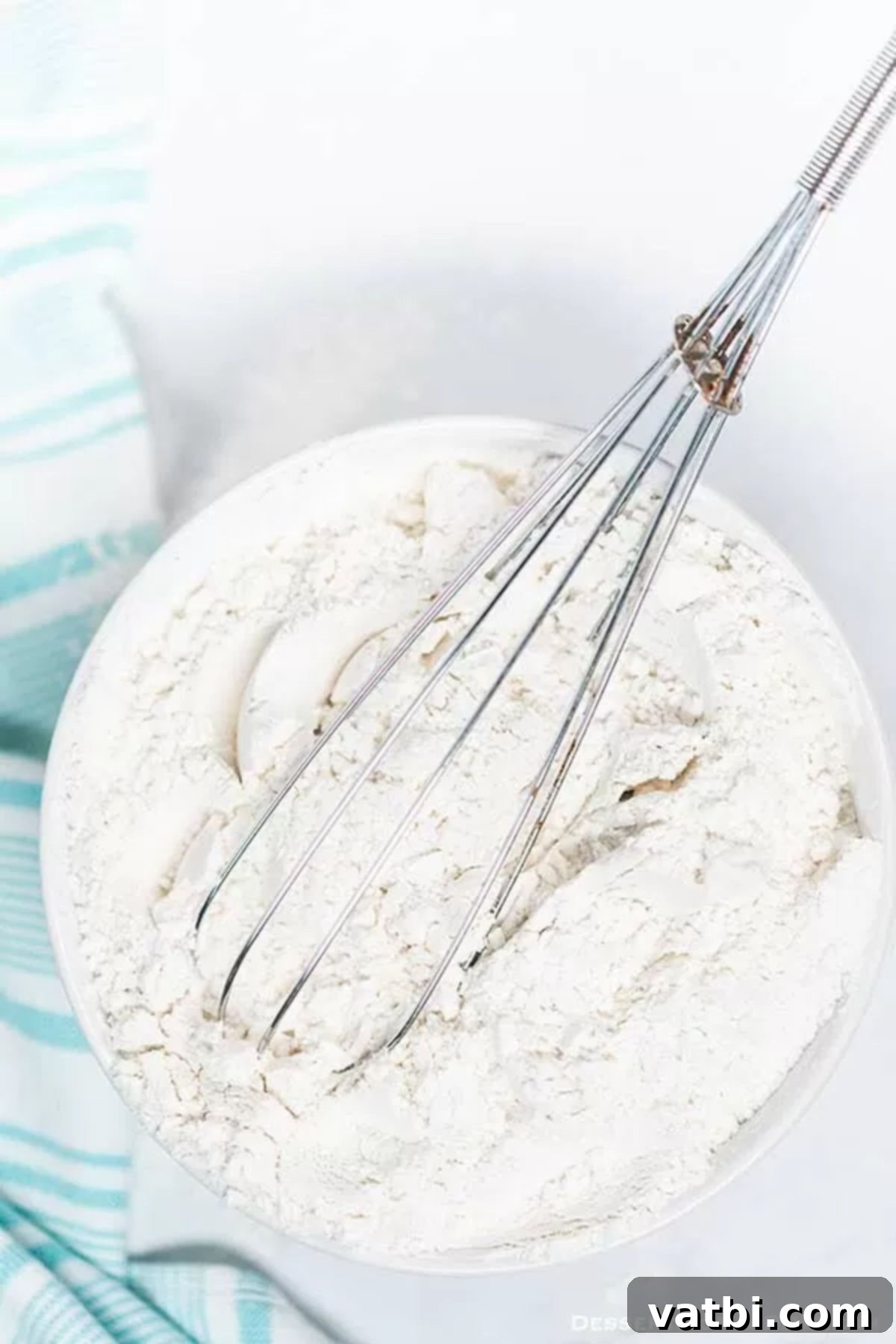
Step 2 – Combine with Cornstarch: To the remaining flour in your measuring cup (which is now just under 1 cup), add 2 level tablespoons of cornstarch. Just like the flour, ensure the cornstarch is measured precisely. Transfer this mixture to a medium-sized bowl. Using a whisk, thoroughly combine the flour and cornstarch. Whisk vigorously for about 30 seconds to a minute, ensuring the cornstarch is evenly distributed throughout the flour. This initial whisking helps to break up any clumps and starts the blending process, crucial for the cornstarch to properly dilute the flour’s protein content.
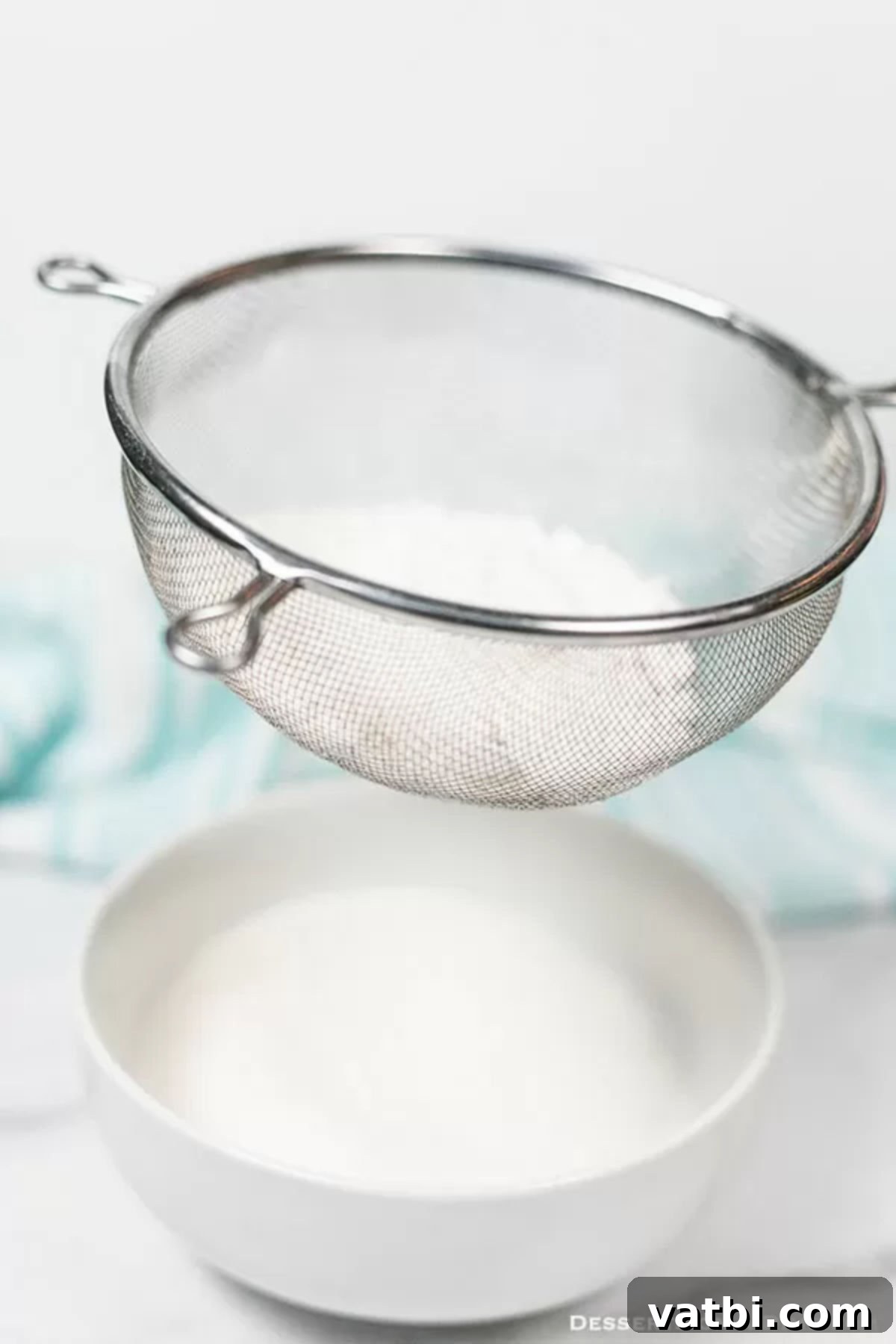
Step 3 – Sift for Perfection: The key to achieving the fine, airy texture of commercial cake flour is sifting. Place a fine-mesh sieve over a clean bowl and pass the flour and cornstarch mixture through it. Repeat this process, sifting the mixture at least twice. Sifting not only ensures that the cornstarch is perfectly integrated with the flour but also aerates the mixture, making it significantly lighter and lump-free. This increased airiness is vital for creating a delicate crumb in your baked goods. While some bakers prefer to sift 4-5 times for ultimate lightness, I find that sifting twice is usually sufficient to achieve a wonderfully soft and consistent homemade cake flour for most recipes. Gently tap the sieve to help the mixture pass through evenly.
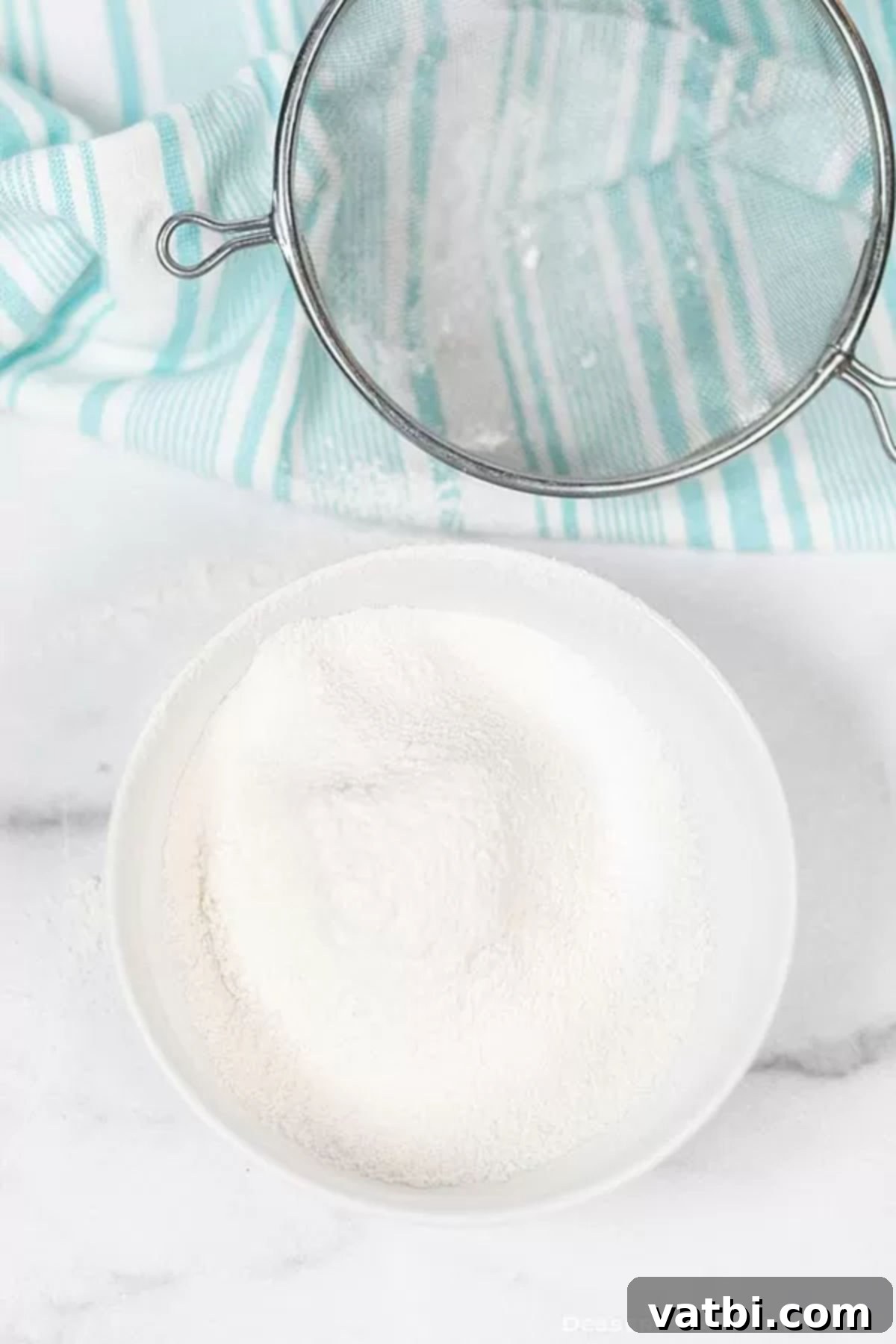
Step 4 – Ready to Use: Congratulations! You now have 1 cup of perfectly crafted homemade cake flour, ready to be used in your favorite recipes! This entire process is incredibly simple, inexpensive, and yields fantastic results that will transform your baking. Use this substitute immediately for your current recipe, or store it for later as outlined in our storage section below. This effortless DIY method ensures your baked goods are always light, moist, and tender, without the need for a special trip to the store.
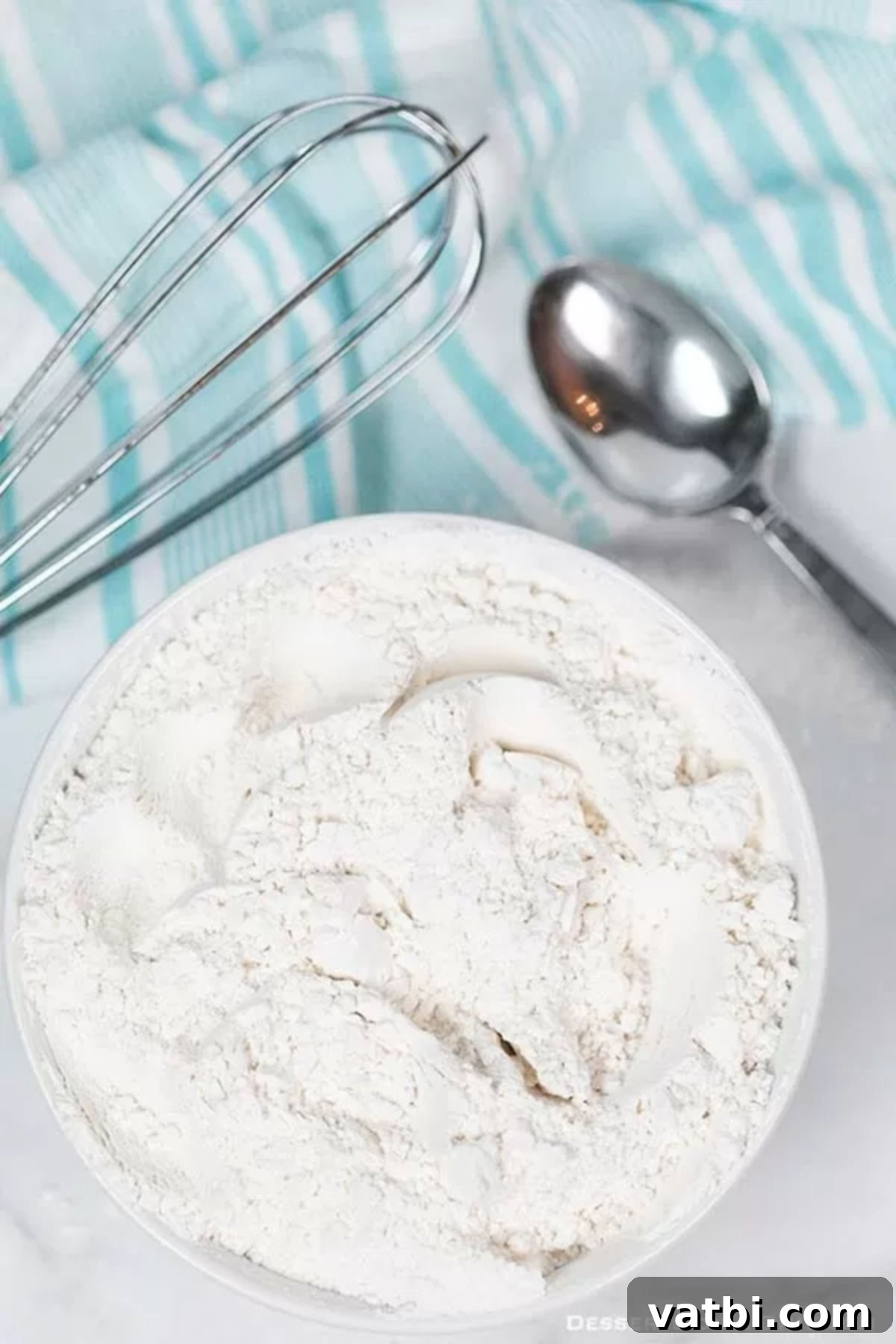
Pro Tips for Perfect Homemade Cake Flour
Mastering homemade cake flour is simple, but a few expert tips can ensure your results are consistently outstanding:
- Accurate Measurement is Key: Precision is paramount in baking, especially when it comes to flour. Always use the “spoon and level” method when measuring your all-purpose flour. Spoon the flour lightly into your measuring cup until it overflows, then use a straight edge (like the back of a knife) to level off the excess. Never scoop flour directly from the bag, as this can compact it and lead to using too much, which will affect the final texture of your baked goods. Similarly, ensure your tablespoons of cornstarch are perfectly level for the correct ratio.
- Don’t Skip the Sifting: Sifting is more than just removing lumps; it’s a critical step for both blending and aeration. It ensures the cornstarch is uniformly distributed throughout the all-purpose flour, creating a consistent low-protein environment. More importantly, sifting introduces air into the mixture, making it lighter and fluffier. This aeration is what helps achieve the signature delicate crumb of cakes. While sifting twice is usually sufficient, if you’re aiming for an ultra-light, cloud-like texture (like for an angel food cake), sifting three or even four times can make a noticeable difference.
- Use Fresh Ingredients: The quality of your ingredients directly impacts the quality of your bake. While flour and cornstarch have a relatively long shelf life, ensure they are fresh and stored properly. Old flour can develop off-flavors or lose its leavening power (if self-rising), impacting the taste and texture of your finished product. Check expiration dates and store in airtight containers to maintain freshness.
- Scaling the Recipe: This recipe is designed to yield 1 cup of cake flour. If your recipe calls for a larger quantity, simply multiply the ingredients proportionally. For instance, for 2 cups of cake flour, you would start with 2 cups of all-purpose flour, remove 4 tablespoons, and then add 4 tablespoons of cornstarch. Always maintain the 2-tablespoons-removed-per-cup-of-flour and 2-tablespoons-cornstarch-per-cup-of-flour ratio, and don’t forget to sift thoroughly after combining.
- Alternative to a Sifter: If you don’t own a fine-mesh sieve, don’t despair! You can still achieve a well-blended and aerated mixture. Place the flour and cornstarch in a large bowl and use a wire whisk to combine them vigorously. Whisk for at least 1-2 minutes, lifting the mixture as you whisk to incorporate as much air as possible. While a sifter provides the absolute best results, extensive whisking is a perfectly acceptable alternative that will still yield a lovely, light cake flour substitute.
Frequently Asked Questions About Homemade Cake Flour
While cake flour excels at creating delicate textures, it’s not a mandatory ingredient for every baking project. It truly shines in recipes where a soft, light, and tender crumb is desired, such as homemade cakes, fluffy cupcakes, airy muffins, and even some delicate cookies. The lower protein content of cake flour prevents excessive gluten development, which can lead to a chewy or dense texture. For example, a classic vanilla cake, a delicate angel food cake, or a tender pound cake will greatly benefit from cake flour’s properties, resulting in a superior melt-in-your-mouth experience. However, for recipes like crusty artisan bread, chewy chocolate chip cookies, or robust pie crusts, all-purpose flour or even bread flour (for bread) is usually preferred. Their higher protein content contributes to the desired structure, chewiness, and crust development that wouldn’t be achieved with cake flour.
The “best” flour for baking largely depends on the specific item you are making and the desired texture. Each type of flour has a unique protein content that dictates its baking properties:
- Cake Flour: Characterized by its very low protein content (typically 6-8%), cake flour creates a fine, silky texture with a delicate, tender crumb. It’s the ideal choice for white cakes, vanilla cakes, angel food cakes, cupcakes, and muffins where extreme softness and tenderness are paramount.
- Pastry Flour: Similar to cake flour but with a slightly higher protein content (8-9%), pastry flour strikes a balance between tenderness and a bit more structure. It’s excellent for pies, tarts, and some cookies where you want a tender but slightly firmer result than cake flour provides.
- All-Purpose Flour: This is the versatile workhorse of the kitchen, with a medium protein content (10-12%). It’s suitable for a vast array of recipes including everyday cookies, quick breads, pancakes, waffles, pie crusts, and pasta. It provides a good balance of structure and tenderness, making it the most commonly used flour.
- Bread Flour: Boasting the highest protein content (12-14%), bread flour is specifically designed for yeast breads. Its high protein forms strong gluten networks, which are essential for creating the characteristic chewy texture, elasticity, and robust structure needed for hearty loaves, pizza dough, and bagels.
Understanding these differences allows you to choose the perfect flour to achieve your desired baking outcome, making you a more knowledgeable and successful baker.
Cake flour, often also referred to as pastry flour due to their similar characteristics, is a specialized type of flour milled from soft wheat varieties. Its defining characteristic is its very low protein content, typically ranging from 6% to 8%. This low protein level is incredibly important because protein is the component in flour that develops into gluten when mixed with liquid. Less protein means less gluten development, which is desirable for achieving a soft, tender, and delicate crumb in baked goods. Commercial cake flours are also often subjected to a bleaching process, which further weakens the protein bonds and allows the flour to absorb more liquid and sugar. This results in a moister cake with a finer texture and better rise. Popular store-bought brands include Swans Down, Softasilk, and King Arthur Unbleached Cake Flour. However, as demonstrated in this guide, it’s remarkably easy and effective to make a perfectly suitable substitute at home using common pantry ingredients.
If a recipe explicitly calls for cake flour and you only have all-purpose flour on hand, you can confidently use this homemade substitution method. The general rule for creating this swap is quite simple and effective: for every 1 cup of cake flour required in a recipe, you will use 1 cup of all-purpose flour, from which you first remove 2 tablespoons. Then, you add 2 tablespoons of cornstarch to the remaining flour. This technique effectively reduces the overall protein content of the all-purpose flour mixture to mimic the low-protein characteristics of commercial cake flour. It is absolutely crucial that you sift the combined flour and cornstarch mixture thoroughly after combining to ensure even distribution and proper aeration. This sifting step is key to achieving that signature delicate and tender cake flour texture in your finished baked goods.
No, pure cake flour, whether homemade using our method or commercially produced (such as brands like Swans Down or Softasilk), typically does not contain any leavening agents. It is simply a type of flour, characterized by its low protein content and fine consistency. Therefore, when a recipe calls for cake flour, you will always need to add the required amount of baking soda or baking powder separately, as specified in your recipe. These leavening agents are essential for creating the chemical reaction that produces carbon dioxide gas, which in turn causes your cakes and other baked goods to rise and develop an airy, light structure. Always check your recipe carefully for the leavening agent requirements, as these are critical for successful baking results.
Absolutely! This homemade cake flour substitute stores beautifully, making it convenient to prepare a larger quantity for future baking projects. Simply multiply the recipe to make the desired amount, always maintaining the consistent ratio of 1 cup all-purpose flour (minus 2 tablespoons) to 2 tablespoons of cornstarch. Once prepared and thoroughly sifted, make sure to store your homemade cake flour in an airtight container. A large glass jar with a tight-fitting lid or a sturdy plastic food storage container works perfectly. Place the container in a cool, dark, and dry pantry, away from direct sunlight and humidity. This will protect it from moisture, pests, and the development of off-flavors. Stored correctly, your homemade cake flour can remain fresh and effective for several months, ensuring it’s ready whenever your next baking craving hits!
Sifting plays a critical dual role in making effective homemade cake flour. Firstly, it ensures that the fine cornstarch powder is uniformly distributed throughout the all-purpose flour. Without thorough mixing and sifting, you might end up with uneven pockets of pure cornstarch or areas of unmodified all-purpose flour, leading to an inconsistent texture in your baked goods (some parts too tender, others too dense). Secondly, and equally important, sifting aerates the flour mixture, making it significantly lighter and fluffier. This process incorporates tiny air pockets into the flour, which directly contributes to the overall tender and airy crumb that cake flour is renowned for. It also helps break up any remaining clumps, ensuring a smooth, fine powder that is easy to incorporate into batters and results in a more delicate, professional-quality bake.
Proper Storage for Longevity
Once you’ve prepared your homemade cake flour, proper storage is essential to maintain its freshness and effectiveness for future baking endeavors. We recommend storing it in an airtight container, such as a large glass jar with a tight-fitting lid, a durable plastic food storage container, or even a heavy-duty freezer bag with all the air pressed out. The key is to protect it from moisture, which can cause clumping and spoilage, and from pests. Place the container in a cool, dark, and dry pantry, away from direct sunlight or sources of heat like ovens or stovetops. Humidity and heat are the enemies of flour, as they can lead to accelerated spoilage or the development of unpleasant off-flavors. Stored correctly under these conditions, your homemade cake flour substitute can last for several months, retaining its delicate properties and ensuring it’s always ready whenever your next baking project calls for it. Labeling the container with the date of preparation is a good practice to easily keep track of its freshness.
Delightful Recipes That Use Cake Flour
Now that you’re equipped with your perfectly prepared homemade cake flour, it’s time to put it to good use and experience the magic it brings to your baking! Here are some fantastic recipes where the delicate touch of cake flour truly makes a difference, resulting in exceptionally moist, tender, and utterly irresistible treats:
- Red White and Blue Cupcakes: Elevate your patriotic celebrations with cupcakes that are not just festive but also incredibly soft and moist. Cake flour ensures these colorful treats have an unbelievably tender crumb that will delight everyone.
- Easy Carrot Cake Cupcakes: Experience the ultimate in soft and flavorful carrot cake cupcakes. The cake flour contributes to a light and airy texture that perfectly complements the rich spices, grated carrots, and creamy frosting, making each bite a pure pleasure.
- Easy Homemade Vanilla Cake Recipe: This is the quintessential recipe to showcase the true magic of cake flour. Expect a velvety smooth, melt-in-your-mouth vanilla cake that’s exceptionally light, airy, and full of classic, comforting flavor. It’s perfect for any occasion and a testament to the power of using the right flour.
Go ahead and try making this incredibly easy and effective homemade cake flour substitute. Whether you’re in a pinch because you ran out of store-bought, or you’re simply seeking to elevate your baking to a new level of tenderness and lightness, this effortless trick is a true game-changer for any home baker. Don’t forget to come back and share your experience by leaving a comment once you’ve tried it – we love hearing about your baking successes and how this simple hack has transformed your desserts!
Pin
How to Make Cake Flour
Ingredients
- 1 cup All-Purpose Flour
- 2 Tablespoons Cornstarch
Instructions
-
From 1 cup of all-purpose flour, remove 2 Tablespoons.
-
Combine the remaining flour with 2 Tablespoons of cornstarch in a bowl and whisk thoroughly until fully integrated.
-
Sift the flour mixture through a fine-mesh sieve twice to ensure perfect blending and aeration.
-
Your homemade cake flour is now ready to use (yields 1 cup).
Nutrition Facts
Pin This Now to Remember It Later
Pin Recipe
